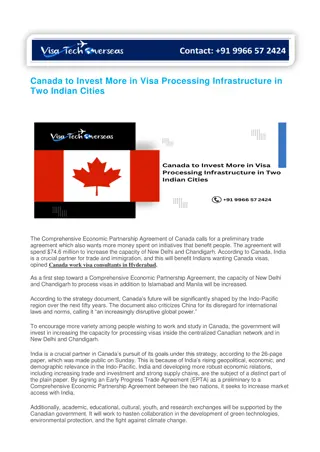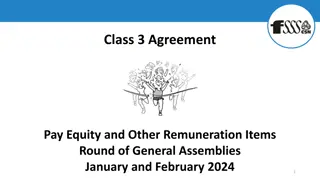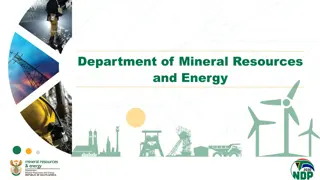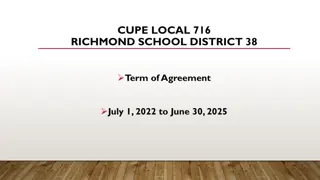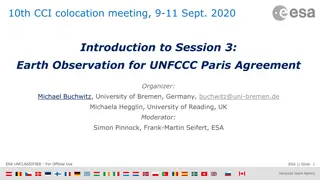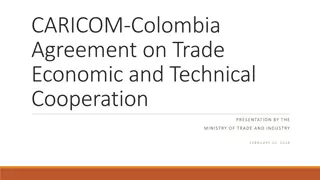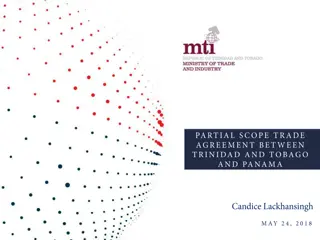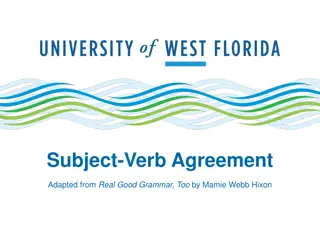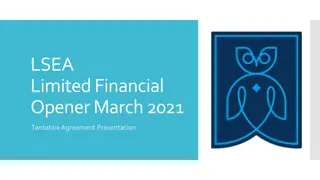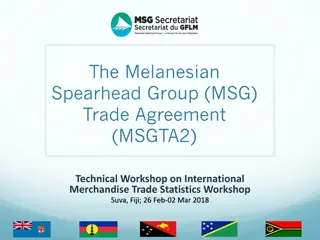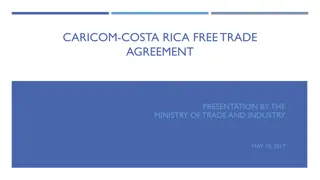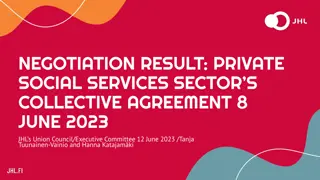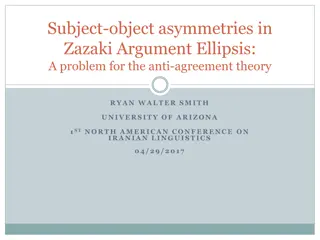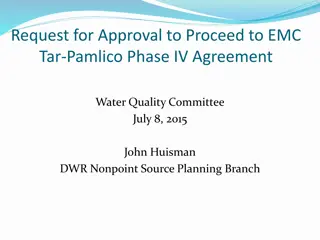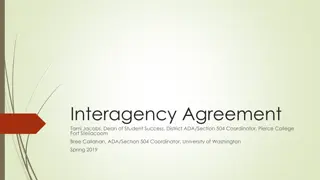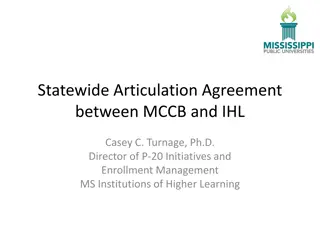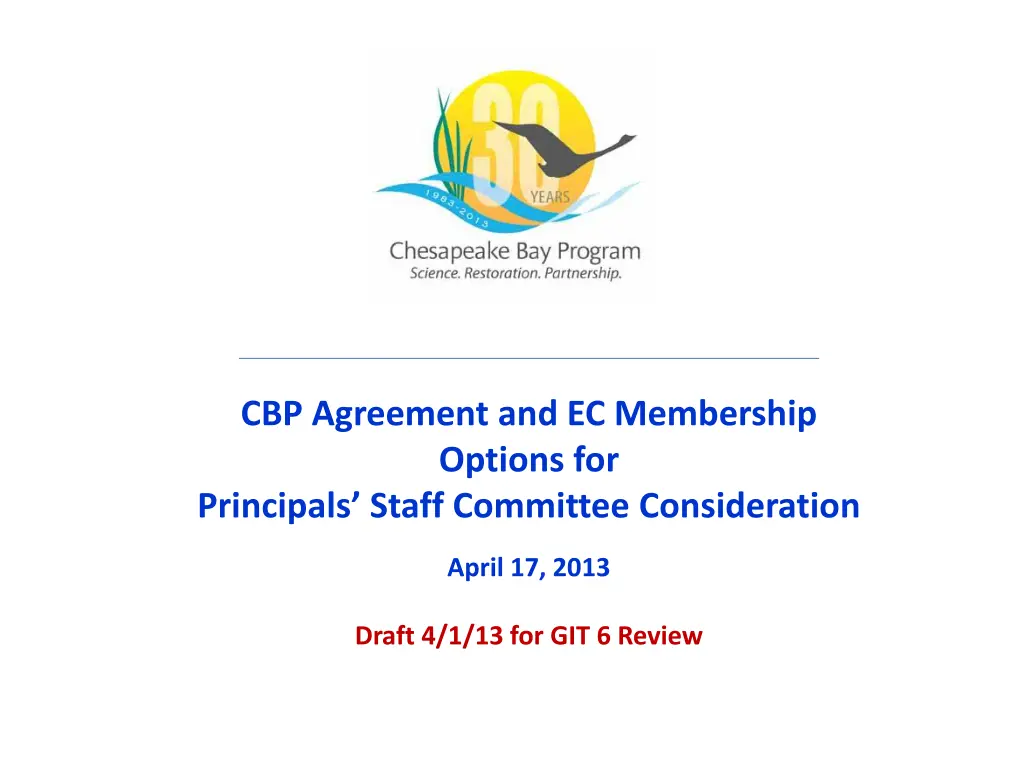
Chesapeake Bay Agreement Options and Key Requirements
Explore the proposed alignment process for Chesapeake Bay Agreement Options, including bifurcated and comprehensive options. Dive into Section 117 of the CWA key requirements and the scope of the Chesapeake Bay Program Office in restoring and protecting the ecosystem. Learn about the formal agreements and membership options for consideration by the Principals Staff Committee.
Uploaded on | 1 Views
Download Presentation

Please find below an Image/Link to download the presentation.
The content on the website is provided AS IS for your information and personal use only. It may not be sold, licensed, or shared on other websites without obtaining consent from the author. If you encounter any issues during the download, it is possible that the publisher has removed the file from their server.
You are allowed to download the files provided on this website for personal or commercial use, subject to the condition that they are used lawfully. All files are the property of their respective owners.
The content on the website is provided AS IS for your information and personal use only. It may not be sold, licensed, or shared on other websites without obtaining consent from the author.
E N D
Presentation Transcript
CBP Agreement and EC Membership Options for Principals Staff Committee Consideration April 17, 2013 Draft 4/1/13 for GIT 6 Review
Proposed Outline for Alignment Process December - January January GIT6 GIT6 - Coordinate effort with GITs to finalize proposed new goals - Establish GIT sub-group fully representative of all partners January 10th MB Meeting MB - Build out potential governance options - Determine next step to finalize goals - Receive MB Input - Build out options for potential new agreement - Determine key governance issues - Look at issues and early decisions needed for agreement MB Input You Are Here March PSC Meeting and here April PSC Meeting March - April PSC GIT6 MB Input MB Input PSC - Adopt or recommend changes to goals - Build out PSC selected options - Final adoption of goals - Provide input and guidance on key governance issues - Coordinate with other GITs to finalize goals - Approve final directive content for adoption at 2013 EC Meeting - Select style of agreement & provide guidance for EC directive - Develop EC directive --- including governance and alignment leading to new agreement 2
Chesapeake Bay Agreement Options for Consideration Option 1 Bifurcated Agreement Option 2 Comprehensive Agreement
Section 117, CWA Key Requirements Chesapeake Bay Agreement (a)(2) the formal, voluntary agreements executed to achieve the goal of restoring and protecting the Chesapeake Bay ecosystemand the living resources of the Chesapeake Bay ecosystem and signed by the Chesapeake Executive Council. Members of the Chesapeake Executive Council (a)(5) the signatories to the Chesapeake Bay Agreement.
Section 117, CWA Key Requirements Scope of the Chesapeake Bay Program Office (b)(2)(B) implementing and coordinating science, research, modeling, support services, monitoring, data collection, and other activities that support the Chesapeake Bay Program; improve the water quality and living resources in the Chesapeake Bay ecosystem developing and implementing specific action plans to carry out the responsibilities of the signatories
Section 117, CWA Key Requirements Granting Funds If a signatory jurisdiction has approved and committed to implement all or substantially all aspects of the Chesapeake Bay Agreement the Administrator (A) shall make a grant to the jurisdiction for the purpose of implementing the management mechanisms established and conditions as the Administrator considers appropriate; and (B) may make a grant to a signatory jurisdiction for the purpose of monitoring the Chesapeake Bay ecosystem.
Why we need a new Agreement Sec. 117 Implementation grants can only be given to Executive Council Members i.e. those that signed on to all or substantially all of the agreement All funding must address a goal as stated in the CB Agreement Implementation grants only go to signatories to the Agreement, all others must compete for funding But .Chesapeake 2000 was the last comprehensive agreement Commitments are largely outdated (any specific dates associated with the agreement are for 2012 or earlier ..e.g. WQ commitment) And, the EC requested that the CBP look at ways to coordinate and align the Partnership s goals with the goals and outcomes of the EO. So ..Any new goals/outcomes that were not a part of Chesapeake 2000 would not be able to be funded using Section 117 funds.
Discussion Process 1. Listen to the Options 2. Discuss and Debate Options 3. Make a Final Decision
Chesapeake Bay Agreement Options for Consideration Option 1 Bifurcated Agreement Option 2 Comprehensive Agreement
Overview of Options Option 1: Bifurcated Agreement Two separate documents: A. Declaration of Commitment B. CBP Statement of Outcomes (CBP Governance and management strategies developed separately)
Overview of Options Part A: Declaration of Commitment Section 1: Preamble Section 2: Vision Section 3: Mission Section 4: Goals Section 5: Membership Section 6: Principles Section 7: Effective Date Section 8: Affirmation and Signatures
Overview of Options Part A: Declaration of Commitment Decisions: EC Membership/Signatories 1. Full/Partial Membership Are there alternatives to full membership? - For example can Partners sign on to only portions of the Agreement (i.e. commit to work only towards certain goals such as water quality, vital habitats or public access)? - If they choose this menu style approach would they be full members of the EC? Would they be full members of the PSC? -Must they abstain from discussion/voting on issues to which they have not agreed to work? 2. Additional future partners if at a future time the FLC or a headwater state desires a place at the EC table, should there be a mechanism for a late signor to the agreement to allow for additional members? 3. Will current headwater states choose to join as full members?
Overview of Options Part B: CBP Statement of Outcomes Sustainable Fisheries Goal Blue Crab Outcome Oyster Outcome Fisheries Outcome Vital Habitats Goal Water Quality Goal Healthy Watersheds Goal Land Conservation Goal Public Access Goal Environmental Literacy Goal Wetlands Outcome Stream Restoration Outcome Fish Passage Outcome Submerged Aquatic Vegetation Outcome Forests Outcome 2025 WIP Outcome 2017 WIP Outcome Healthy Waters Outcome Protected Lands Outcome Public Access Site Development Outcome Education Outcome: TBD
Overview of Options Part B: CBP Statement of Outcomes Decisions: Agreement and Outcomes 1. Are Part A (Declaration) and Part B (CBP Outcomes) stand- alone documents or do they, as a package, comprise the Chesapeake Bay Agreement? 2. Should both Part A and Part B be developed and adopted at the same time or could the CBP Outcomes document be developed at a later time? 3. How often should the CBP Outcomes document be renewed/updated and should the EC or PSC adopt renewed outcomes?
Overview of Options Part B: CBP Statement of Outcomes Decision: Signing on to Outcomes 1. Should the Outcomes document be signed by the EC or PSC? 2. Should the original outcomes be signed by the EC but any necessary revisions be delegated to the PSC with an annual update to the EC? 3. Should partners identify in this document those outcomes they commit to working toward? 4. Can partners sign on/commit only to working towards water quality goals and outcomes?
Overview of Options Part B: CBP Statement of Outcomes (or Section 4 of Comprehensive Agreement) Decision: Identification of Responsible Entities 1. Should the signatories sign off on each goal area and outcome they commit to working toward individually?
Overview of Options Supporting Document: Governance Guidelines Decisions: Governance Guidelines 1. Should the Governance Guidelines be a completely separate, stand-alone document or should it be linked to the Declaration or part of the Chesapeake Bay Agreement package? 2. What part of the organization should sign off on the document, the PSC or Management Board? 3. How often should the CBP Governance document be renewed/updated?
Overview of Options Supporting Document: Management Strategies Decisions: Management Strategies 1. Should the Partnership develop management strategies to implement actions to achieve outcomes identified in Part B of the Bifurcated Agreement (Option 1) or in the Agreement itself (Option 2)? 2. What part of the organization should sign off on the document, the PSC or Management Board?
Overview of Options Option 2: Comprehensive Agreement 2013 Chesapeake Bay Agreement Section 1: Preamble Section 2: Vision Section 3: Mission Section 4: Goals and Outcomes Section 5: Membership Section 6: Principals Section 7: Effective Date Section 8: Affirmation and Signatures Appendix: CBP Governance, Management Strategies (or separate document)
Overview of Options Option 2: Comprehensive Agreement Decision: Frequency of Agreement/Goals Renewal How frequently would this agreement type be updated so that goals, outcomes, indicators and measures remain current?
Overview of Options Additional Decision Points TMDL Governance Decision: Treatment of TMDL issues in the Partnership Option 1: Non-TMDL option Retain the current governing body structure and membership of CBP, but take TMDL out of the partnership elements of the program; other water quality issues would be retained by CBP Partnership (monitoring, model, etc.) Option 2: Separate Regulatory Aspects of TMDLDistinguish the nature of TMDLs as a regulatory requirement of section 303(d) of the Clean Water Act, distinct and apart from section 117 of the CWA and have separate EPA/co-regulator discussions with bay jurisdictions as needed.. Ensure that the TMDL aspects of the program are addressed as one of the tools to achieve clean water goals under the Water Quality Goal Implementation Team.
Overview of Options Additional Decision Points Decision: PSC Participation and Voting Eligibility Option 1: Status quo EC designees (member/participating partner; level of state secretaries, DDOE Director, CBC E.D., federal agencies). Multiple members from same delegations at the table, but only one vote allowed per delegation (e.g. EPA votes for all feds who are represented by either FLCD member or Regional Director). STAC, CAC and LGAC chairs invited, but may not vote. Option 2: Retain current membership, however, members may only vote on issues according to what they have signed onto (i.e. if only signed on to water quality, they may only vote on water quality issues). Option 3: Only signatory jurisdictions at the table /eligible to vote; other partners serve in an advisory capacity.
Overview of Options Additional Decision Points Decision: PSC/MB Voting Privileges Option 1: Only signatories get one vote each. Option 1.a: Signatories get one vote each.If there is an option that allows for signatories to sign on to specific goals and outcomes, those signatories would be limited to voting only on issues related to the goals on which they signed. Option 2: Delegation-style vote (for program-wide implications). 9 total votes, 1 per jurisdiction and CBC plus 1 vote for federal agencies. (EPA will always hold the 1 federal vote and should seek input from/through the FOD or FLC/D).
Overview of Options Key Components Preamble - history, benefits and accomplishments Vision Mission Goals and Outcomes - Clean Water - Restoring Resources Governance and Structure (by-laws) -PSC, MB, GITS, - Role of Federal Partners Membership Principals Effective Date Affirmation and Signatures
Executive Council Meeting Decision Points: Focus Areas? 30th Anniversary of the Chesapeake Bay Program Signing of the New Agreement Timing Should we move the timing of the EC meeting to late September/early October?

